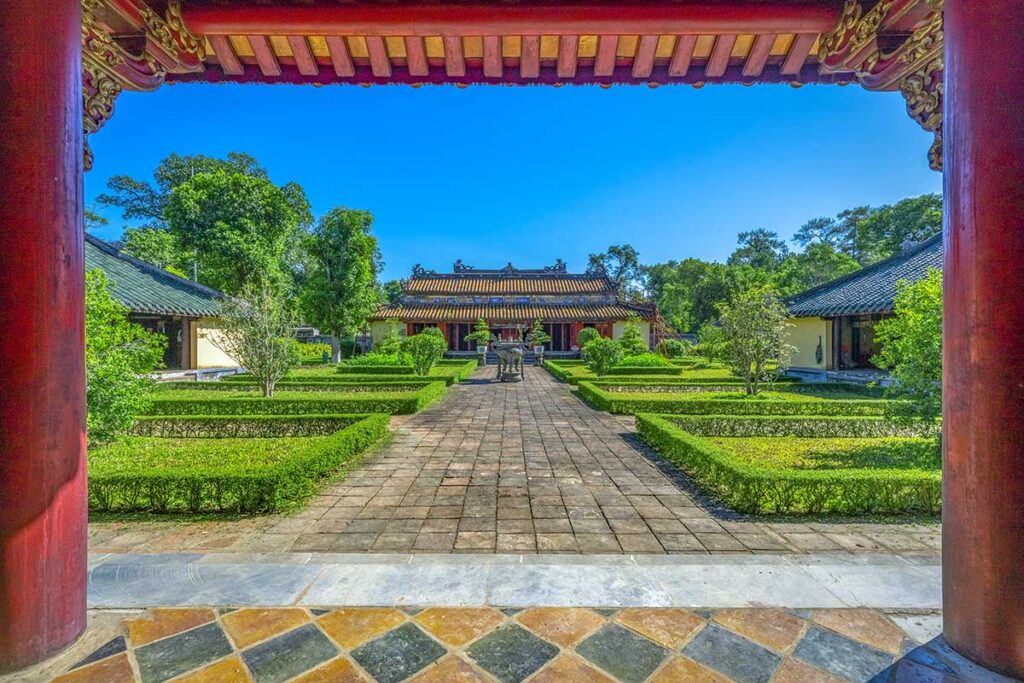What is Gia Long Tomb?
The Mausoleum of Emperor Gia Long is the final resting place of the founder of the Nguyen Dynasty, located deep in the countryside southwest of Hue. Built in the early 1800s, it is the oldest of Hue’s royal tombs and sits peacefully along the Perfume River, surrounded by pine-covered hills. While less visited than other sites, the Gia Long Mausoleum marks the beginning of Hue’s imperial legacy and offers valuable insight into Vietnam’s last dynasty and its tradition of elaborate imperial burials.
Who was emperor Gia Long?
Emperor Gia Long, born Nguyễn Phúc Ánh in 1762, was the founding emperor of the Nguyễn Dynasty and one of the most important figures in Vietnamese history. He spent much of his early life as a fugitive during the collapse of the southern Nguyễn lords, surviving multiple assassination attempts and enduring years of warfare against the Tây Sơn rebels. With strategic military campaigns and help from foreign allies — notably French officers and missionaries — he gradually regained lost territory and unified Vietnam in 1802 under the new dynastic name Gia Long, combining “Gia” from Gia Định (Saigon) and “Long” from Thăng Long (Hanoi), symbolizing the unification of north and south.
Once on the throne, Gia Long moved the capital to Hue, solidified central rule, and began constructing what would become the Hue Imperial City. He implemented Confucian principles in administration, restructured the state’s military, and sought to maintain independence from growing Western influence while cautiously modernizing certain aspects of governance. Though some criticized his reliance on foreign advisors and suppression of Christianity, his reign was defined by stability and consolidation. He ruled until his death in 1820, passing the throne to his son Minh Mang — and was buried in one of the most remote and serene royal mausoleums in Hue.
History of Gia Long Tomb
The Mausoleum of Emperor Gia Long was the first royal tomb constructed by the Nguyễn Dynasty and set the tone for those that followed. Built between 1814 and 1820, it was commissioned by Gia Long himself several years before his death and completed just in time for his burial. The location was chosen deep in the countryside on the west bank of the Perfume River, far removed from Hue’s city center. Surrounded by mountains and forests, the site offered both natural protection and symbolic alignment with geomantic (feng shui) principles — considered essential for an emperor’s eternal resting place.
Uniquely, the tomb was designed not just for Gia Long alone but also to reflect the deep bond with his wife, Empress Thừa Thiên Cao Hoàng hậu. Her tomb was constructed directly beside his, a rare gesture of personal devotion in Vietnamese imperial tradition. Later, the area evolved into a full complex of smaller tombs and family graves, including his son Prince Cảnh. The site remained significant to the Nguyễn family, though it eventually faded from public view due to its remote location and the later prominence of tombs closer to Hue. Despite the passage of time, Gia Long’s tomb endures as a powerful reminder of the dynasty’s founding and the emperor who united Vietnam.
Layout of Gia Long Tomb

Highlights & architecture
The Mausoleum of Emperor Gia Long isn’t just one tomb—it’s a vast complex spread across forested hills and tranquil valleys. Unlike the more compact royal tombs near Hue city, this one invites exploration. Here are the main highlights you’ll see when visiting:
1. Entrance fate and Worship area

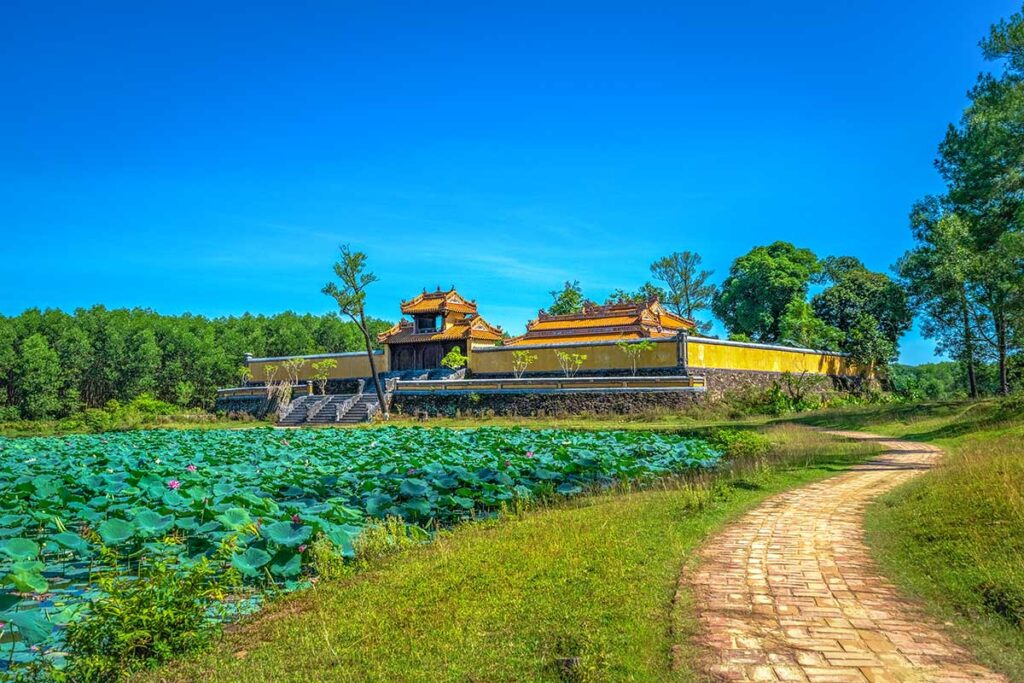
Your journey through Gia Long’s mausoleum begins at a formal triple-arched gate, opening into a quiet courtyard with a large lotus pond and the ruins of ancestral worship buildings.
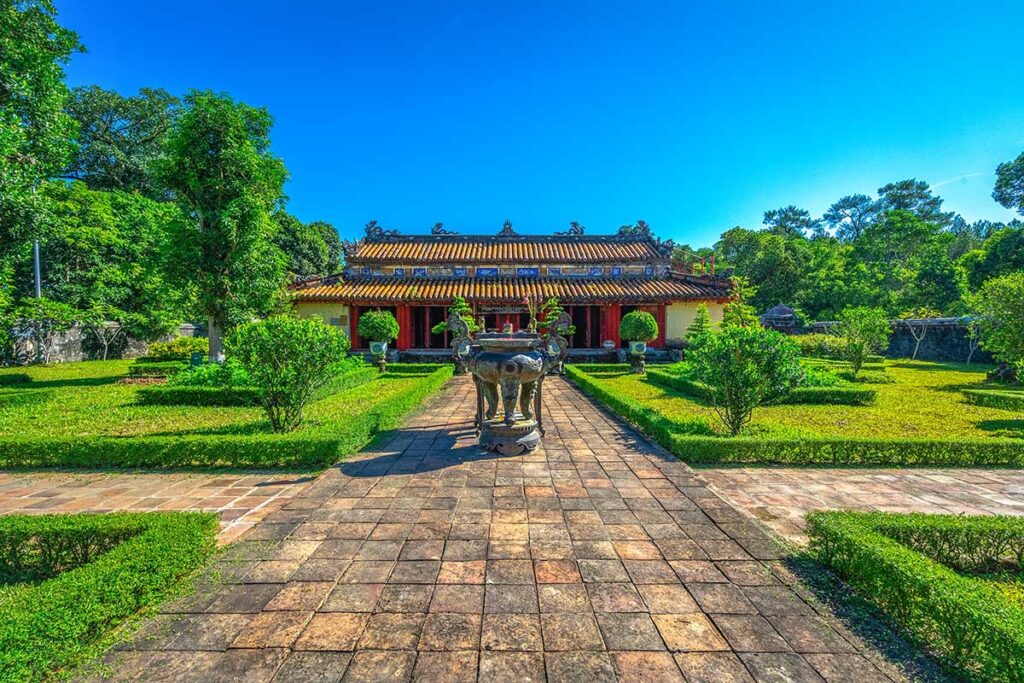
This area once served as the ceremonial heart of the complex, where offerings were made to the emperor and empress. The main temple (Điện Minh Thành) and surrounding pavilions followed the classic Confucian layout—gate, pond, courtyard, and altar—mirroring the spiritual journey from the earthly world to the afterlife.
2. The Twin Tombs of Emperor and Empress
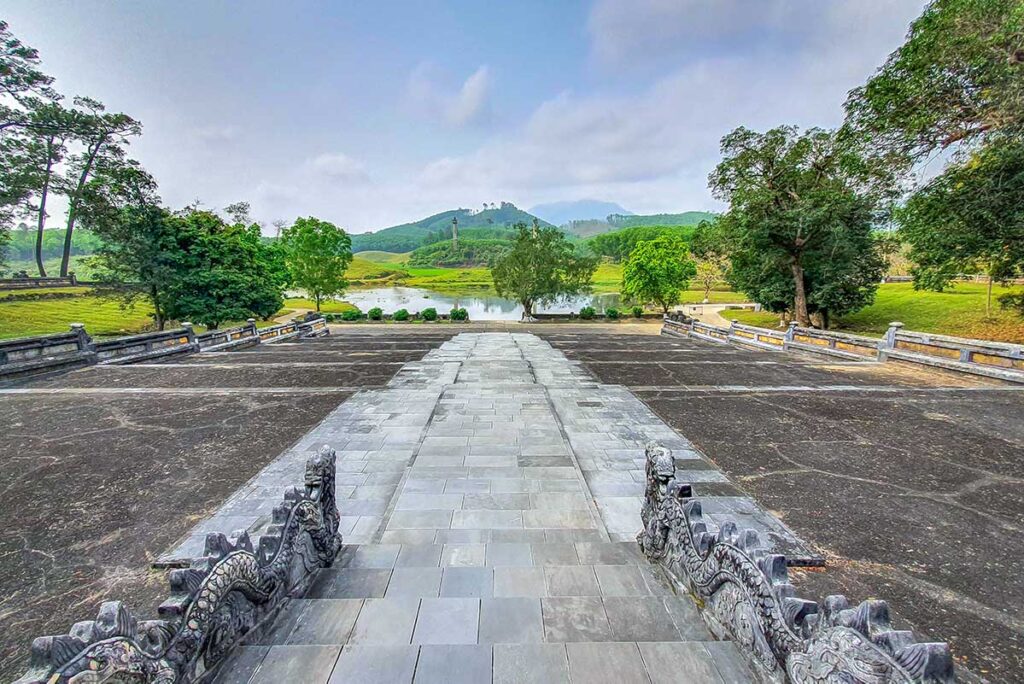
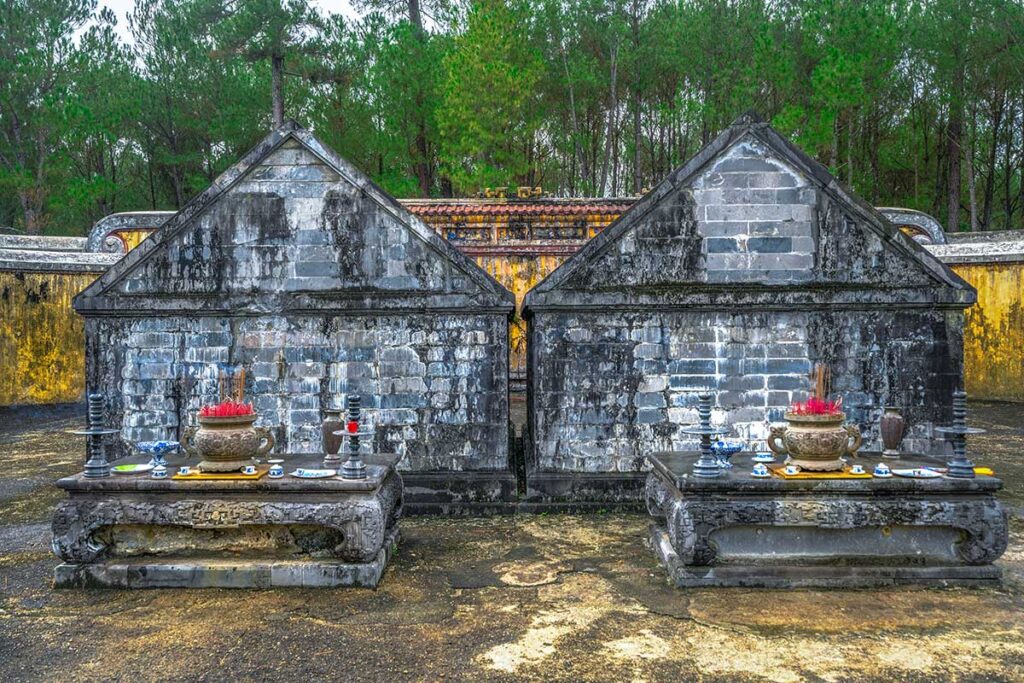
At the heart of the complex lie two nearly identical tombs—one for Gia Long and one for his wife, Empress Thừa Thiên. Built side by side on a raised terrace, they are symbolic of the emperor’s deep affection for his queen. Each tomb is enclosed by stone walls and features simple yet harmonious architecture, focused more on natural balance than royal display. This joint burial is rare among Hue’s royal mausoleums and makes the site feel more personal and human.
3. Bái Đình Courtyard and Honor Guards
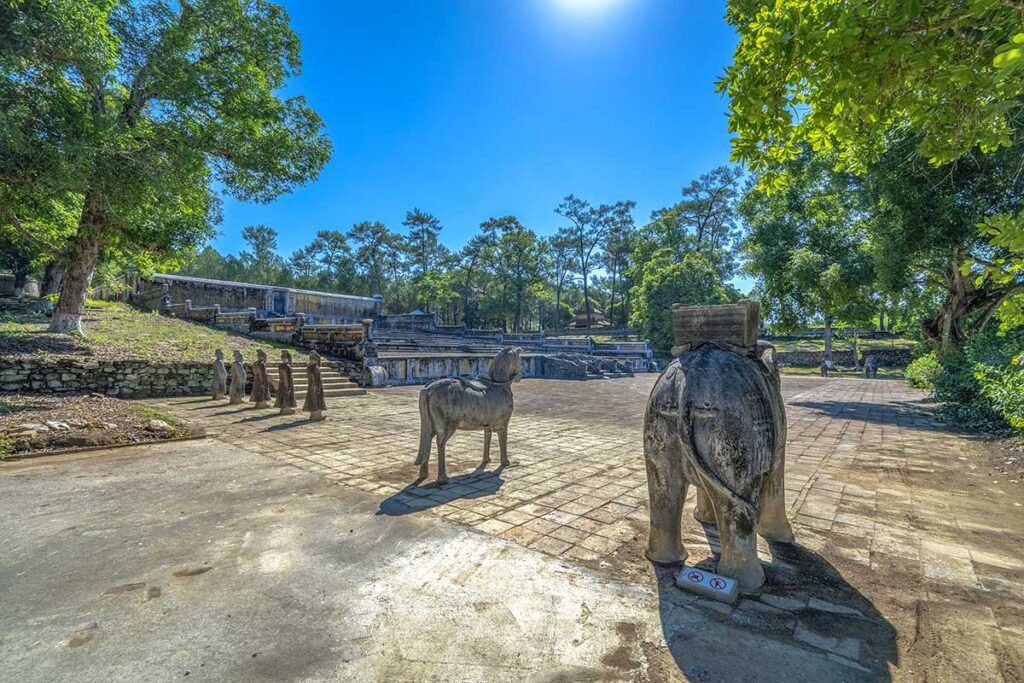
Approaching the central tombs, you’ll pass through a long paved courtyard lined with traditional stone statues of mandarins, elephants, and horses—symbolic protectors of the imperial soul. This ceremonial space, known as the Bái Đình, reflects Confucian hierarchy and the emperor’s eternal status. Despite being weathered by time, many of these statues remain intact and are striking in their scale and detail.
4. The Stele Pavilion (Bi Đình)

Just before reaching the main tomb terrace, you’ll find the stele pavilion housing a massive stone tablet inscribed with a eulogy written by Emperor Minh Mang, Gia Long’s son. The tablet praises his father’s achievements in unifying Vietnam and establishing a stable government. Architecturally, the pavilion is simple but elegant, sheltering the stele from the elements under a tiled roof supported by carved wooden beams.
5. Surrounding natural landscape
Part of what makes the Gia Long Mausoleum so special is the setting itself. The complex was built in alignment with geomantic principles (similar to feng shui), nestled between mountains and overlooking the Perfume River. The layout stretches across rolling hills and includes natural ponds and small streams, blending the site with the landscape instead of dominating it. The peaceful surroundings and lack of tourist crowds give the whole area a calm, meditative atmosphere.
6. Family tombs and additional structures
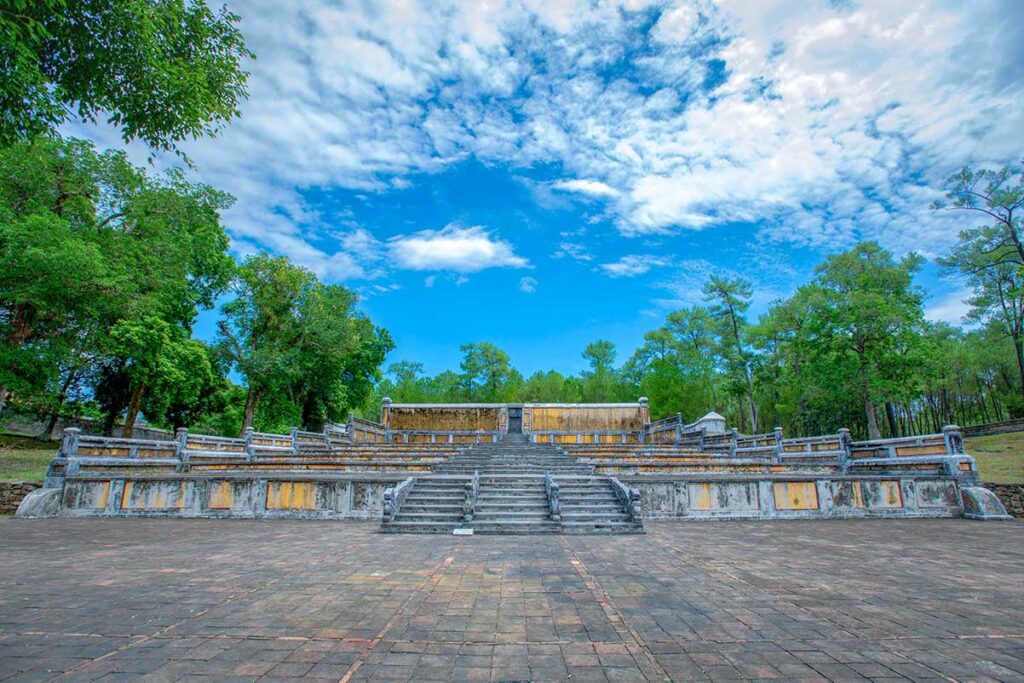
Beyond the central tombs, you’ll find a number of smaller tombs belonging to other royal family members, including Prince Cảnh. These secondary structures are more modest but form part of the overall harmony of the layout. You’ll also come across gateways, pathways, and remnants of former pavilions that once served ritual and administrative purposes during imperial ceremonies.
Visiting information & Practical tips
Location
The Mausoleum of Emperor Gia Long is located in Huong Tho commune, southwest of Hue. It lies deep in the countryside on the western bank of the Perfume River, approximately 16 kilometers from Hue’s city center. The remote setting adds to its peaceful atmosphere but also means it requires more time and planning to reach.
Entrance fee
- 100,000 VND per adult
Opening times
- 7:00 AM – 5:30 PM
Dress code
There is no official dress code, and enforcement is relaxed. However, as this is the burial site of an emperor, it’s highly recommended to dress modestly out of respect—avoid overly short shorts or sleeveless tops.
Guides
You can explore the Gia Long Mausoleum without a guide, but informational signage is very limited. Hiring a guide (especially one knowledgeable in Vietnamese royal history) can provide helpful context about the emperor’s life and the site’s symbolism. Without a guide, the experience is still enjoyable, but some of the historical and cultural depth may be lost.
Nearby sights
While the Gia Long Mausoleum is one of the most remote royal tombs in Hue, it can be included in a scenic route that passes several other major tombs. If you’re coming from Hue city center, here are some logical stops along the way:
- Mausoleum of Emperor Thieu Tri: The first tomb you’ll pass, known for its peaceful, lesser-visited setting.
- Mausoleum of Emperor Minh Mang: Right along the route from the same direction, this is one of Hue’s most majestic and symmetrical tombs.
- Mausoleum of Emperor Khai Dinh: If you take an alternative return route, you drive passed this striking tomb, famous for its elaborate interior and unique fusion of Eastern and Western styles.
This makes Gia Long Tomb ideal for a loop itinerary, especially if you’re traveling by motorbike or car and want to explore multiple imperial sites in one day.
Travel Tip: These three tombs can be visited in a loop — start with Thieu Tri and Minh Mang on the way to Gia Long, then return via the road that passes Khai Dinh. This is a great option for those exploring by motorbike, scooter, or private car.
How to get to Gia Long Tomb?
Taxi or grab app
Taking a taxi or using the Grab app is a convenient way to reach the Gia Long Mausoleum. The tomb is located approximately 20 km from Hue’s city center, and the journey typically takes about 30 minutes. Taxi fares are metered, averaging around 15,000 VND per kilometer, so expect to pay approximately 300,000 VND for a one-way trip.
Alternatively, the Grab app offers both car and motorbike options. Grab is widely used in Vietnam and allows you to book rides conveniently through your smartphone. The app provides fare estimates, and payment can be made in cash or via the app, depending on your preference.
Cycling or scooter
Renting a scooter is a popular choice for adventurous travelers who prefer flexibility. Scooter rentals in Hue typically cost between 120,000 to 150,000 VND per day. The ride to the Gia Long Mausoleum offers scenic views of the countryside, but be prepared for varying road conditions. Ensure you’re comfortable with navigating rural roads and always wear a helmet for safety.
Dragon boat trip
For a unique and leisurely experience, consider taking a dragon boat along the Perfume River to reach the Gia Long Mausoleum. This journey covers approximately 18 km and offers picturesque views of the river and surrounding landscapes. A private dragon boat trip from Toa Kham Wharf to the tomb costs around 2,600,000 VND. Note that the boat doesn’t dock directly at the tomb; you’ll need to arrange a short walk or transfer from the riverbank to the mausoleum.
Tour
The Gia Long Mausoleum is less frequented by standard tours due to its distance from the city and its more understated grandeur compared to other tombs. However, private tours can be arranged, offering a customized itinerary that may include a dragon boat trip to the tomb followed by a car ride back to Hue. This option provides both convenience and a deeper understanding of the site’s historical significance.
More historical sights in Hue
The Mausoleum of Emperor Gia Long is just one part of Hue’s vast imperial heritage. As the former capital of Vietnam during the Nguyen Dynasty, Hue is home to some of the country’s most important historical sites — from royal tombs to ancient temples and imperial palaces. If you’re exploring Gia Long’s legacy, consider adding these nearby highlights to your trip:
- Hue Imperial City – The political and ceremonial heart of the Nguyen Dynasty, featuring throne halls, ancestral temples, royal courtyards, and the remains of the Forbidden Purple City.
- Tu Duc Tomb – A peaceful, poetic complex built by and for the emperor himself as a personal retreat. Known for its scenic layout of pavilions, lakes, and gardens.
- Minh Mang Tomb – Famous for its grand, symmetrical design rooted in Confucian values. Surrounded by forested hills and lotus ponds, it’s one of Hue’s most majestic tombs.
- Khai Dinh Tomb – A striking mix of Vietnamese and European styles, with a dark concrete exterior and an incredibly ornate interior covered in colorful glass mosaics.
- Thien Mu Pagoda – Hue’s most iconic pagoda, overlooking the Perfume River. A spiritual symbol of the city with a long history tied to both Buddhism and Vietnamese politics.
For a complete overview of these and other must-see places, read our guide: 10 Best Temples, Pagodas & Tombs in Hue
